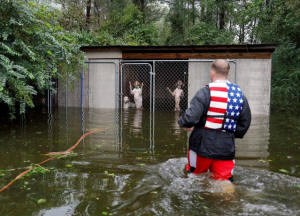|
Worst flooding yet to come for
waterlogged Carolinas
 Send a link to a friend
Send a link to a friend
 [September 17, 2018]
By Ernest Scheyder and Anna Mehler Paperny [September 17, 2018]
By Ernest Scheyder and Anna Mehler Paperny
WILMINGTON/WILSON, N.C. (Reuters) - Deadly
storm Florence moved across western North Carolina early on Monday and
continued to dump rain that has nowhere to go except to swell rivers,
flood highways and homes, and threaten more lives as it heads towards
Virginia and New England.
For the water-logged Carolinas, "the worst is yet to come" as river
levels rise to historic levels, said Zach Taylor, a meteorologist with
the U.S. National Weather Service.
"The soil is soaked and can't absorb any more rain, so that water has to
go somewhere, unfortunately," he said. "Those rivers are going to start
to crest later today and Tuesday and maybe longer."
Flash floods, landslide warnings and "prolonged significant river
flooding" throughout the region will continue for the next few days, the
National Weather Service (NWS) said.
The coastal city of Wilmington remained cut off by high flood waters
early on Monday, tens of thousands of homes were damaged and at least 17
deaths were reported in North and South Carolina.
Florence, a onetime hurricane that weakened to a tropical depression by
Sunday, is expected to decline in force again on Monday before
re-intensifying on Tuesday and Wednesday, the U.S. National Hurricane
Center said.
It has dumped up to 40 inches (100 cm) of rain on North Carolina since
Thursday and continued to produce heavy rain over much of North Carolina
and eastern South Carolina, the NWS said.

An additional 2 to 5 inches of rain is expected with isolated areas of 8
inches possible through Tuesday in the Carolinas and Virginia.
"The storm has never been more dangerous than it is right now," North
Carolina Governor Roy Cooper told a news conference.
More than 900 people were rescued from rising floodwaters and 15,000
remained in shelters in the state, Cooper said.
Many rescues took place on swift boats in Wilmington, a coastal city of
about 117,000 people on a peninsula between the Cape Fear River and the
Atlantic Ocean.
Rescue crews negotiated downed trees and power lines to reach stranded
residents, Mayor Bill Saffo told WHQR radio.
"There are no roads ... that are leading into Wilmington that are
passable because of the flooding that is taking place now inland," Saffo
said.
Officials urged people who had been evacuated to stay away.
"Our roads are flooded, there is no access into Wilmington," New Hanover
County Commission Chairman Woody White told a news conference. "We want
you home, but you can't come yet."
UNPRECEDENTED FLOODING
In Leland, a low-lying city north of Wilmington, homes and businesses
were engulfed by water that rose up to 10 feet (3 meters) over Highway
17 in what local people called unprecedented flooding.
[to top of second column]
|

Panicked dogs that were left caged by an owner who fled rising flood
waters in the aftermath of Hurricane Florence, are rescued by
volunteer rescuer Ryan Nichols of Longview, Texas, in Leland, North
Carolina, U.S., September 16, 2018. REUTERS/Jonathan Drake

The sheriff's department and volunteers rescued stranded residents
by boat, extracting families, infants, the elderly and pets. Gas
stations were abandoned and fallen trees made many roads impassable.
More than 641,000 homes and businesses were without electricity in
North and South Carolina and surrounding states, down from a peak of
nearly 1 million.
Florence set a state record for rain from a hurricane, surpassing
the previous high of 24 inches (61 cm) from Hurricane Floyd which
killed 56 people in 1999, said Bryce Link, a meteorologist with
private forecasting service DTN Marine Weather.
The storm killed at least 11 people in North Carolina, including a
mother and child hit by a falling tree, state officials said. Six
people died in South Carolina, including four in car accidents and
two from carbon monoxide from a portable generator.
South Carolina's governor urged anyone in a flood-prone area to
evacuate.
"Those rivers in North Carolina that have received heavy rainfall
are coming our way," Governor Henry McMaster told a news conference.
"They have not even begun (to crest). But they will. And the
question is how high will the water be, and we do not know."
By 5 a.m. on Monday, Florence's winds had dropped to about 30 miles
per hour (45 kph), the NWS said, with weakening forecast over the
next 24 hours before intensifying again as an extratropical
low-pressure center.The center of the storm was about 125 miles (200
km) west southwest of Roanoke, Virginia and moving northeast at 13
mph (20 kph), the weather service said.
(Reporting by Anna Mehler Paperny and Ernest Scheyder; Additional
reporting by Bernie Woodall in Miami; Jessica Resnick-Ault in New
York and Makini Brice in Washington; and Rich McKay in Atlanta;
Writing by Lisa Shumaker and Daniel Trotta; Editing by Jonathan
Oatis and Ed Osmond)
[© 2018 Thomson Reuters. All rights
reserved.]
Copyright 2018 Reuters. All rights reserved. This material may not be published,
broadcast, rewritten or redistributed.
Thompson Reuters is solely responsible for this content.
 |